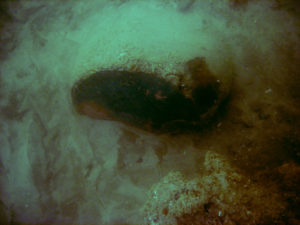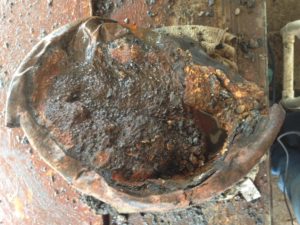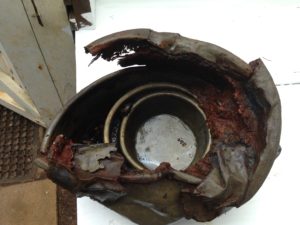You never know exactly what you will come across when conserving artifacts.
When an artifact is found on site, it is documented, photographed and X-rayed to determine what it is and if it’s something of interest to conserve. Sometimes, though, objects will be too thick or have too much material in the way to give a clear X-ray image.
Fortunately, in some instances, the artifact is identifiable and easier to work on.
In December 2010, LAMP archaeologists revisited the Storm Wreck site and saw numerous newly exposed artifacts. One such item was what looked like a large pot or cauldron. When examined underwater it appeared to be made of copper. Divers documented the find, marked the location and left it behind for possible excavation during the next field season.

Artifact on site
When the summer field school started again in June 2011, the archaeologists came across the pot again, but did not recognize the artifact. In between the initial discovery and the summer field season, the bottom of the pot had fallen apart.
With the bottom missing, though, it was possible to see a second pot inside of the first.

Artifact seen from above
With the assistance of a grant sponsored in part by the Department of State, Division of Historical Resources and the State of Florida, I started conservation on the pots. This began with air-scribing the exterior and chiseling off all of the concreted sand and shell. In the process of removing the sediment and debris, I came to find out that there were not two pots, but a total of four pots nested within each other.

Artifact with outer layer of concretion removed
I removed as much concretion as possible, but there was still too much material in between the pots holding them together. In order to separate the pots and continue with the conservation process, they are now going through electrolysis. Each individual pot is connected separately to the negative anode in order to conduct a current through the metal.
Artifact with interior concretion removed.

This artifact is one of many that we hope to include in a new Storm Wreck exhibit coming to the museum in Spring 2016.
Click here to find out more about the Storm Wreck, a 1782 British Loyalist shipwreck found off St. Augustine’s coast by lighthouse archaeologists. You can also see more about the ongoing conservation of hundreds of artifacts recovered from this shipwreck right here on our lighthouse blog.
Andrew Thomson is the Assistant Conservator for the St. Augustine Lighthouse & Museum. He received his graduate degree and training from the Conservation Research Laboratory at Texas A&M.



